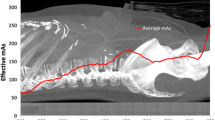Abstract
The X-ray effective energy differs for each computed tomography (CT) scanner even at the same tube voltage because of differences in the bow-tie filter and additional filter. Even when scanning with the same tube voltage and dose setting, these differences in effective energy result in different image noise levels. Although this qualitative change is known, the related quantitative changes have not been clarified. In this study, using two CT scanners with the same geometric specifications and detector configurations, we quantitatively assessed the reduction in image noise accompanying the increase in effective energy. We also clarified the fluctuations in CT number. For both CT scanners, the effective energy, the standard deviation (SD) of the noise image when using two water phantoms with diameters of 240 mm and 320 mm, and CT numbers of the sensitometry module were measured. Further, the dose required to obtain the same image noise level in each CT scanner was calculated. The effective energy difference was 5.5 keV to 10.7 keV, and the difference tended to be larger when the scan field of view was larger. The SD differences were 24% and 14% for the 320-mm and 240-mm phantoms, respectively. For converting to the dose required to obtain the same SD, the dose can be reduced by 42% and 24% for the 320-mm and 240-mm phantoms, respectively. The CT number difference of both CT scanners was small. Therefore, higher effective energy contributes to the reduction of image noise.




Similar content being viewed by others
References
Matsubara K, Ichikawa K, Murasaki Y, Hirosawa A, Koshida K (2014) Accuracy of measuring half-and quarter-value layers and appropriate aperture width of a convenient method using a lead-covered case in X-ray computed tomography. J Appl Clin Med Phys 15:309–316
Akaishi H, Takeda H, Kanazawa Y, Yoshii Y, Asanuma O (2016) Development of a lead-covered case for a wireless X-ray output analyzer to perform CT half-value layer measurements [in Japanese]. Jpn J Radiol Technol 72:244–250
Iida H, Noto K, Mitsui W, Takata T, Yamamoto T, Matsubara K (2011) A new method of measuring effective energy using copper-pipe absorbers in X-ray CT [in Japanese]. Jpn J Radiol Technol 67:1183–1191
Massoumzadeh P, Don S, Hildebolt CF, Bae KT, Whiting BR (2009) Validation of CT dose-reduction simulation. Med phys 36:174–189
Harpen MD (1999) A simple theorem relating noise and patient dose in computed tomography. Med phys 26:2231–2234
Habibzadeh MA, Ay MR, Asl AK, Ghadiri H, Zaidi H (2012) Impact of miscentering on patient dose and image noise in x-ray CT imaging: phantom and clinical studies. Phys Med 28:191–199
Toth T, Ge Z (2007) The influence of patient centering on CT dose and image noise. Med phys 34:3093–3101
Karmazyn B, Liang Y, Klahr P, Jennings SG (2013) Effect of tube voltage on CT noise levels in different phantom sizes. AJR Am J Roentgenol 200:1001–1005
Ronaldson JP, Zainon R, Scott NJA, Gieseg SP, Butler AP, Butler PH, Anderson NG (2012) Toward quantifying the composition of soft tissues by spectral CT with Medipix3. Med phys 39:6847–6857
Bartzsch S, Oelfke U (2013) A new concept of pencil beam dose calculation for 40–200 keV photons using analytical dose kernels. Med phys 40:111714
Haghighi RR, Chatterjee S, Vyas A, Kumar P, Thulkar S (2011) X-ray attenuation coefficient of mixtures: inputs for dual-energy CT. Med phys 38:5270–5279
National Institute of Standards and Technology. Element/Compound/Mixture Selection. https://physics.nist.gov/PhysRefData/Xcom/html/xcom1.html Accessed 13 July 2019.
Shin J-B, Yoon D-K, Pak S, Kwon Y-H, Suh TS (2020) Comparative performance analysis for abdominal phantom ROI detectability according to CT reconstruction algorithm: ADMIRE. J Appl Clin Med Phys 21(1):136–143
Siegel MJ, Schmidt B, Bradley D, Suess C, Hildebolt C (2004) Radiation dose and image quality in pediatric CT: effect of technical factors and phantom size and shape. Radiology 233:515–522
Funama Y, Awai K, Nakayama Y, Kakei K, Nagasue N, Shimamura M et al (2005) Radiation dose reduction without degradation of low-contrast detectability at abdominal multisection CT with a low–tube voltage technique: phantom study. Radiology 237:905–910
Reid J, Gamberoni J, Dong F, Davros W (2010) Optimization of kVp and mAs for pediatric low-dose simulated abdominal CT: is it best to base parameter selection on object circumference. Am J Roentgenol 195:1015–1020
Shimonobo T, Funama Y, Utsunomiya D, Nakaura T, Oda S, Kiguchi M et al (2016) Low-tube-voltage selection for non-contrast-enhanced CT: comparison of the radiation dose in pediatric and adult phantoms. Phys Med 32:197–201
Author information
Authors and Affiliations
Corresponding author
Ethics declarations
Conflict of interest
The authors declare that they have no conflicts of interest.
Additional information
Publisher's Note
Springer Nature remains neutral with regard to jurisdictional claims in published maps and institutional affiliations.
Rights and permissions
About this article
Cite this article
Ishiguro, A., Sato, K., Taura, M. et al. Quantitative evaluation of the effect of changes in effective energy on the image quality in X-ray computed tomography. Phys Eng Sci Med 43, 567–575 (2020). https://doi.org/10.1007/s13246-020-00857-4
Received:
Accepted:
Published:
Issue Date:
DOI: https://doi.org/10.1007/s13246-020-00857-4




